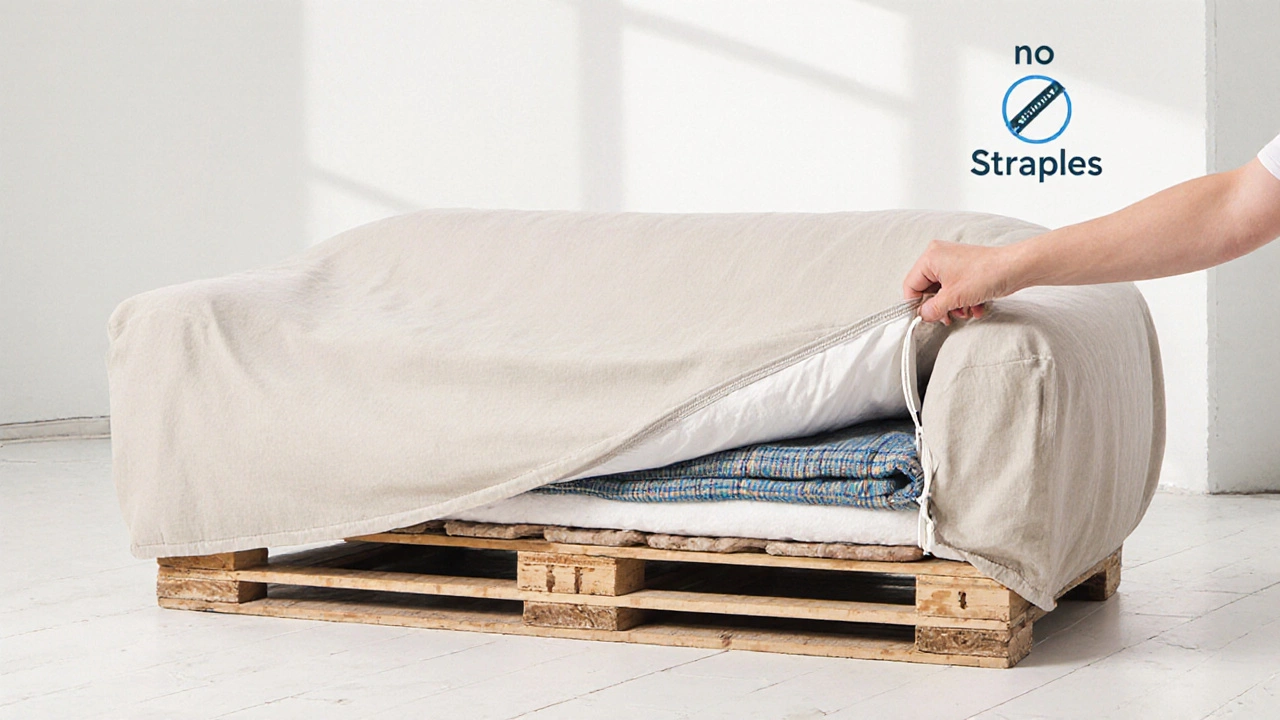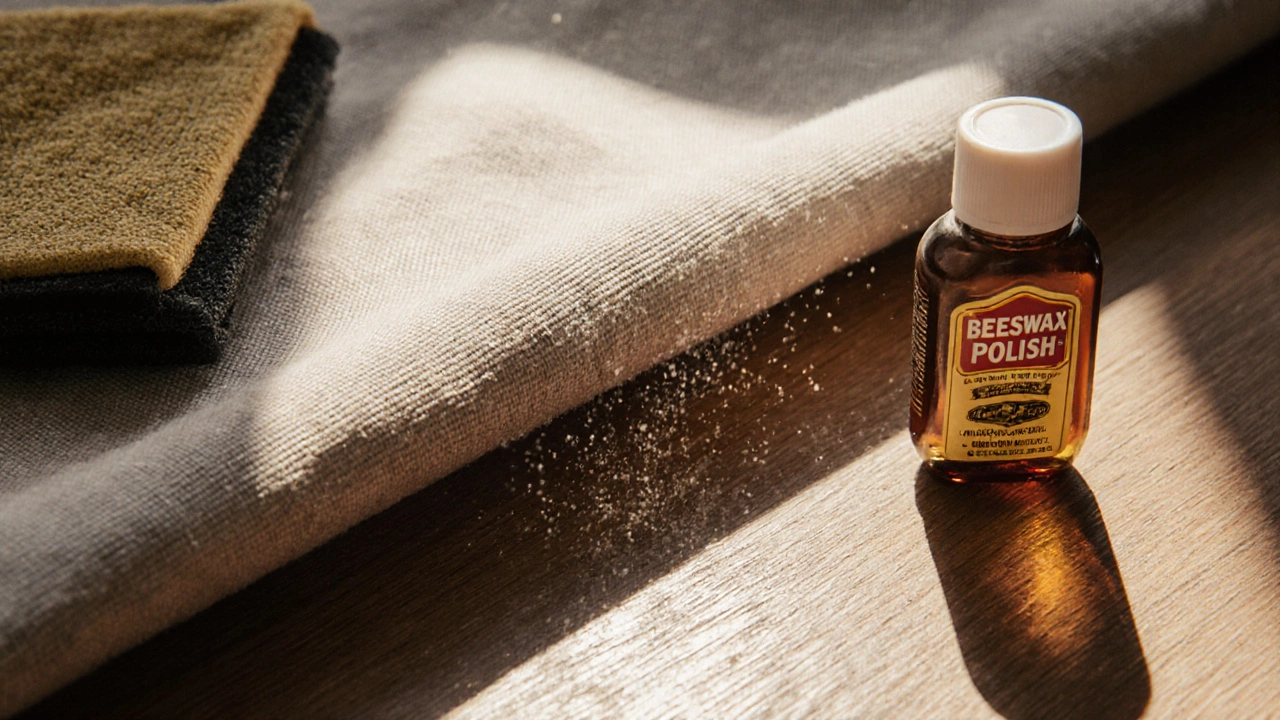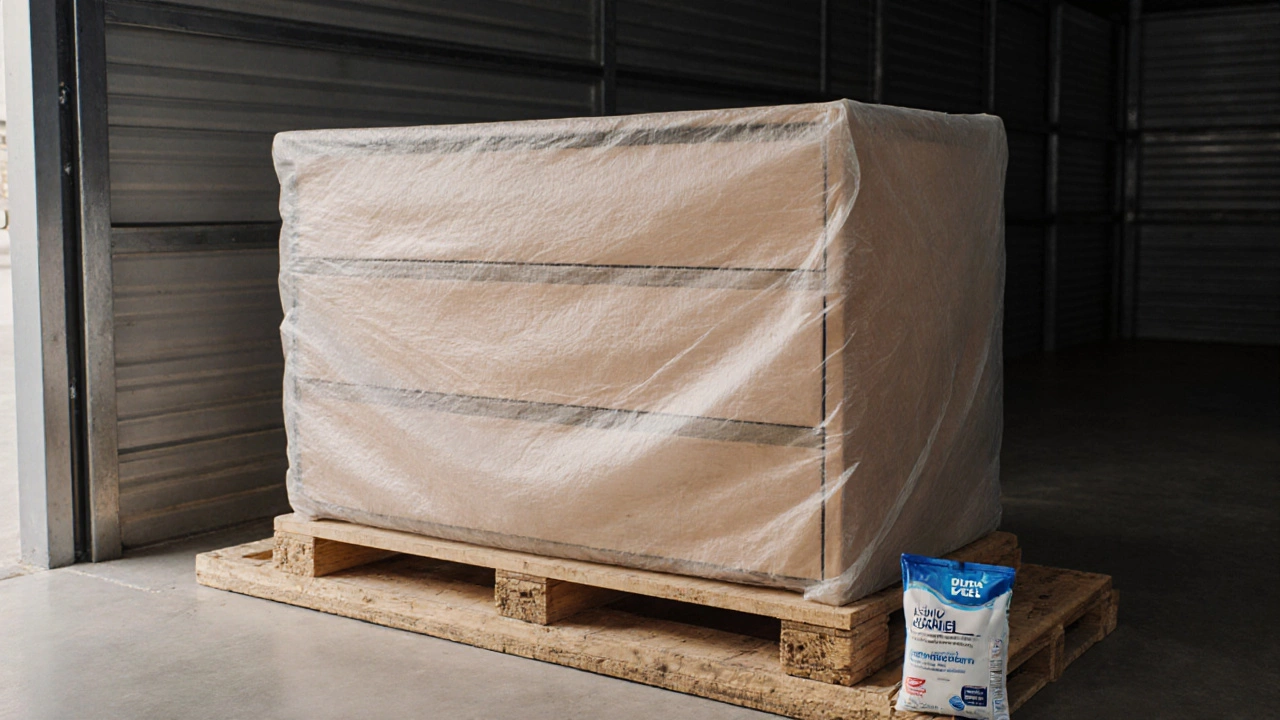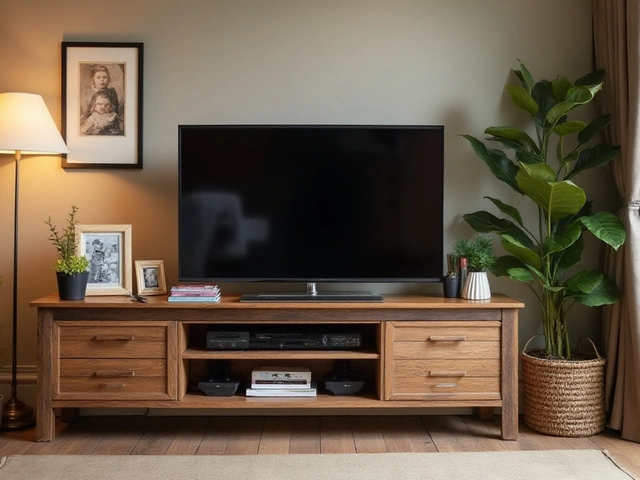Furniture Cover Selector Tool
Select Your Storage Scenario
Storing furniture doesn’t mean just tossing it into a garage or unit and walking away. If you don’t cover it properly, dust, moisture, pests, and temperature swings can ruin wood finishes, tear fabrics, warp frames, and leave you with expensive damage when you pull it out months later. The right cover isn’t just a sheet-it’s your furniture’s shield. Here’s how to do it right, whether you’re storing a sofa, a dining table, or a wooden dresser for a few weeks or a few years.
Why Covering Furniture Matters
People think, ‘It’s just sitting in a closet,’ but storage environments aren’t clean rooms. Basements leak. Attics get hot. Moving trucks aren’t climate-controlled. Even a dry storage unit can have humidity spikes. Without protection, your furniture absorbs moisture, collects dust that scratches surfaces, and becomes a home for mold, mildew, or insects like carpet beetles.
Wood swells and cracks. Upholstery fades and stains. Metal legs rust. Leather dries out and cracks. A $500 cover can save you $5,000 in repairs or replacements. It’s not optional-it’s insurance.
What to Use: Types of Furniture Covers
Not all covers are made equal. The material you pick depends on what you’re storing and where.
- Non-woven polyester covers - Best for most furniture. Breathable, dust-proof, and water-resistant. They don’t trap moisture like plastic, which can cause mold. Brands like ULINE and The Container Store sell these in various sizes.
- Cotton canvas covers - Heavier and more durable. Great for long-term storage of heavy items like dressers or armoires. They’re not waterproof, but they’re breathable and won’t scratch surfaces.
- Plastic shrink wrap - Only for short-term moves or indoor storage. Never use it for long-term storage. It traps moisture and causes condensation, which rotting wood and mildew.
- Specialty covers - Some companies sell fitted covers for sofas, mattresses, or dining sets. These have zippers, elastic hems, and reinforced corners. Worth it if you store the same pieces regularly.
Avoid cheap plastic tarps from hardware stores. They look like protection, but they turn your furniture into a greenhouse. Moisture gets in, can’t escape, and stays. Result? Stained fabric, warped wood, and a musty smell that won’t wash out.
Step-by-Step: How to Cover Furniture for Storage
Follow these steps every time, no exceptions.
- Clean everything first. Dust, dirt, and food crumbs attract pests. Wipe wood with a damp cloth and dry immediately. Vacuum upholstery thoroughly. Spot-clean stains with a mild cleaner. Let everything dry completely before covering.
- Disassemble where possible. Take off legs from tables, remove shelves from bookcases, detach arms from sofas. This reduces stress on joints and makes covering easier. Store screws and small parts in labeled ziplock bags taped to the frame.
- Use padding under the cover. Place old blankets, moving pads, or foam sheets between the furniture and the cover. This prevents scratches and absorbs minor bumps during transport or stacking.
- Wrap in breathable fabric. Drape the cover loosely over the piece. Don’t stretch it tight. Leave room for air to circulate. Secure with tape or ties, but never staple-it punctures the fabric and creates moisture traps.
- Seal the bottom. If storing on a concrete floor, place a plastic sheet or pallet underneath. Then cover the whole thing with your breathable fabric. This lifts the furniture off damp ground and keeps moisture from creeping up.
- Label everything. Write the item and room on the cover with a permanent marker. If you have multiple similar pieces, number them and take a photo of the setup before storing.

What Not to Do
Even experienced people mess up. Here are the biggest mistakes:
- Using plastic wrap for long-term storage - This is the #1 cause of mold on upholstered furniture. It looks sealed, but it’s actually creating a steam room inside.
- Storing covered furniture on the floor - Concrete and wood floors hold moisture. Always use pallets, risers, or wooden blocks.
- Leaving drawers full - Drawers can warp or stick if heavy. Empty them. Store clothes or linens in plastic bins with silica gel packs.
- Ignoring climate - If you’re storing in a humid area (like Florida or a basement), use a dehumidifier in the storage unit. Even a small one helps.
- Using old bedsheets - They’re thin, don’t block dust, and can snag on hardware. Plus, they’re not designed for storage. They tear, fade, and leave lint behind.
Special Cases: Sofas, Wood, and Glass
Some furniture needs extra care.
Sofas and Sectionals: Use a fitted cover with elastic edges. Cover the arms and back separately if needed. Place a towel under the cushions to absorb sweat and oils. Never stack items on top of a covered sofa-it crushes the padding and distorts the shape.
Wood Furniture: Apply a thin coat of beeswax polish before covering. It seals the pores and repels moisture. Avoid silicone-based polishes-they attract dust and leave sticky residue.
Glass Tops and Mirrors: Cover with cardboard first, then wrap in a soft cloth. Tape the edges with painter’s tape, not duct tape. Glass can shatter if bumped, and tape can leave gunk on the surface.
Where to Store Covered Furniture
Where you put it matters as much as how you cover it.
- Climate-controlled storage units - Best option. Keep temperature between 55°F and 75°F, humidity below 50%. Ideal for wood, leather, and fabric.
- Garages and basements - Only if you elevate the furniture and use a dehumidifier. Avoid these if you live in a rainy or humid climate.
- Attics - Too hot in summer, too cold in winter. Avoid unless you’re storing metal or plastic items.
- Under-bed storage - Fine for short-term. Use breathable bins, not plastic. Keep away from direct sunlight.
Check your storage space every 2-3 months. Lift a corner of the cover. Look for dampness, dust buildup, or odors. If you smell anything musty, air it out immediately.

How Long Can You Store Covered Furniture?
With proper covering and climate control, most furniture can sit safely for 1-5 years. But it’s not set-and-forget.
Every 6 months, remove the cover for 15 minutes. Let air circulate. Wipe down surfaces with a dry microfiber cloth. Reapply wax to wood if needed. Rotate items if stacked. This small habit prevents long-term damage.
Leather and velvet need extra attention. They dry out faster. Use a leather conditioner every 3-4 months, even in storage.
What to Do When You Unpack
Don’t just pull the cover off and start using it.
- Let the furniture sit in the room for 24 hours. This lets it adjust to humidity levels.
- Wipe down all surfaces with a slightly damp cloth. Remove dust that settled under the cover.
- Check for stains, warping, or pest damage. Address issues right away.
- Reassemble pieces carefully. Tighten screws gently-over-tightening can strip wood.
If you notice mold, don’t scrub it. Use a mixture of 1 part white vinegar to 1 part water. Spray lightly, let sit 10 minutes, then wipe with a clean cloth. For severe cases, call a professional restorer.
Can I use plastic garbage bags to cover furniture?
No. Plastic garbage bags trap moisture and cause condensation, which leads to mold, mildew, and wood rot. Even if the bag looks sealed, humidity builds up inside. Use breathable covers made of non-woven polyester or cotton canvas instead.
Should I cover furniture before or after moving it into storage?
Cover it right before placing it in storage. Moving furniture while covered can cause tears or misalignment. Clean and disassemble first, then cover just before loading. This keeps the cover clean and intact.
Do I need to cover metal furniture legs?
Yes. Metal legs can rust if they touch damp concrete or moisture in the air. Wrap them in foam pipe insulation or place them on plastic caps. You can also spray them with a light coat of rust inhibitor before covering the whole piece.
Is it okay to store furniture in a shed?
Only if the shed is dry, elevated, and well-ventilated. Most sheds get too hot in summer and too damp in winter. If you must use one, place furniture on wooden pallets, use breathable covers, and add silica gel packs inside drawers. Check monthly for moisture or pests.
How do I prevent pests from getting under the cover?
Clean the furniture thoroughly before covering. Use cedar blocks or lavender sachets near the base of the piece-never taped to the fabric. Avoid storing near food, cardboard boxes, or old rugs. Check the cover every few months for holes or signs of insects.
Final Tip: Think Like a Pro
Storage pros don’t just cover furniture-they plan for it. They know humidity changes with seasons. They know leather shrinks in dry air. They know wood expands when it breathes. Your goal isn’t to hide the furniture. It’s to keep it healthy. Use breathable covers. Control moisture. Check regularly. And don’t forget: the best storage isn’t the one with the most space-it’s the one that keeps your stuff in the best shape.





